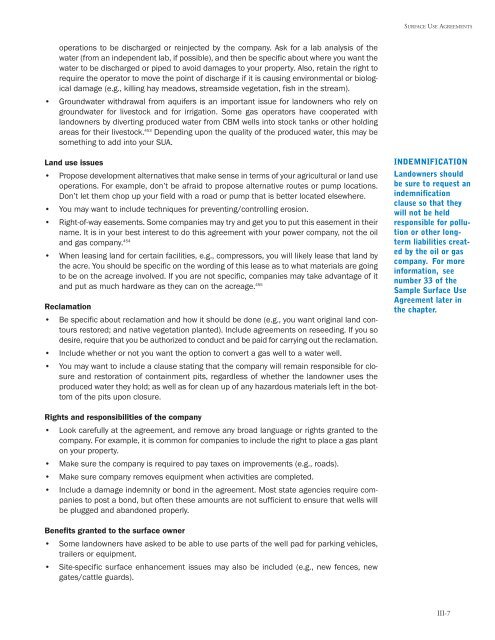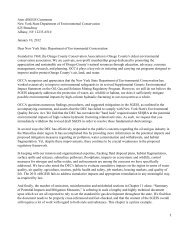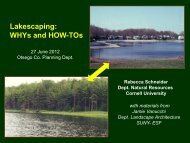Oil and Gas at Your Door? (2005 Edition) - Earthworks
Oil and Gas at Your Door? (2005 Edition) - Earthworks
Oil and Gas at Your Door? (2005 Edition) - Earthworks
Create successful ePaper yourself
Turn your PDF publications into a flip-book with our unique Google optimized e-Paper software.
SURFACE USE AGREEMENTS<br />
oper<strong>at</strong>ions to be discharged or reinjected by the company. Ask for a lab analysis of the<br />
w<strong>at</strong>er (from an independent lab, if possible), <strong>and</strong> then be specific about where you want the<br />
w<strong>at</strong>er to be discharged or piped to avoid damages to your property. Also, retain the right to<br />
require the oper<strong>at</strong>or to move the point of discharge if it is causing environmental or biological<br />
damage (e.g., killing hay meadows, streamside veget<strong>at</strong>ion, fish in the stream).<br />
• Groundw<strong>at</strong>er withdrawal from aquifers is an important issue for l<strong>and</strong>owners who rely on<br />
groundw<strong>at</strong>er for livestock <strong>and</strong> for irrig<strong>at</strong>ion. Some gas oper<strong>at</strong>ors have cooper<strong>at</strong>ed with<br />
l<strong>and</strong>owners by diverting produced w<strong>at</strong>er from CBM wells into stock tanks or other holding<br />
areas for their livestock. 453 Depending upon the quality of the produced w<strong>at</strong>er, this may be<br />
something to add into your SUA.<br />
L<strong>and</strong> use issues<br />
• Propose development altern<strong>at</strong>ives th<strong>at</strong> make sense in terms of your agricultural or l<strong>and</strong> use<br />
oper<strong>at</strong>ions. For example, don’t be afraid to propose altern<strong>at</strong>ive routes or pump loc<strong>at</strong>ions.<br />
Don’t let them chop up your field with a road or pump th<strong>at</strong> is better loc<strong>at</strong>ed elsewhere.<br />
• You may want to include techniques for preventing/controlling erosion.<br />
• Right-of-way easements. Some companies may try <strong>and</strong> get you to put this easement in their<br />
name. It is in your best interest to do this agreement with your power company, not the oil<br />
<strong>and</strong> gas company. 454<br />
• When leasing l<strong>and</strong> for certain facilities, e.g., compressors, you will likely lease th<strong>at</strong> l<strong>and</strong> by<br />
the acre. You should be specific on the wording of this lease as to wh<strong>at</strong> m<strong>at</strong>erials are going<br />
to be on the acreage involved. If you are not specific, companies may take advantage of it<br />
<strong>and</strong> put as much hardware as they can on the acreage. 455<br />
Reclam<strong>at</strong>ion<br />
• Be specific about reclam<strong>at</strong>ion <strong>and</strong> how it should be done (e.g., you want original l<strong>and</strong> contours<br />
restored; <strong>and</strong> n<strong>at</strong>ive veget<strong>at</strong>ion planted). Include agreements on reseeding. If you so<br />
desire, require th<strong>at</strong> you be authorized to conduct <strong>and</strong> be paid for carrying out the reclam<strong>at</strong>ion.<br />
• Include whether or not you want the option to convert a gas well to a w<strong>at</strong>er well.<br />
• You may want to include a clause st<strong>at</strong>ing th<strong>at</strong> the company will remain responsible for closure<br />
<strong>and</strong> restor<strong>at</strong>ion of containment pits, regardless of whether the l<strong>and</strong>owner uses the<br />
produced w<strong>at</strong>er they hold; as well as for clean up of any hazardous m<strong>at</strong>erials left in the bottom<br />
of the pits upon closure.<br />
INDEMNIFICATION<br />
L<strong>and</strong>owners should<br />
be sure to request an<br />
indemnific<strong>at</strong>ion<br />
clause so th<strong>at</strong> they<br />
will not be held<br />
responsible for pollution<br />
or other longterm<br />
liabilities cre<strong>at</strong>ed<br />
by the oil or gas<br />
company. For more<br />
inform<strong>at</strong>ion, see<br />
number 33 of the<br />
Sample Surface Use<br />
Agreement l<strong>at</strong>er in<br />
the chapter.<br />
Rights <strong>and</strong> responsibilities of the company<br />
• Look carefully <strong>at</strong> the agreement, <strong>and</strong> remove any broad language or rights granted to the<br />
company. For example, it is common for companies to include the right to place a gas plant<br />
on your property.<br />
• Make sure the company is required to pay taxes on improvements (e.g., roads).<br />
• Make sure company removes equipment when activities are completed.<br />
• Include a damage indemnity or bond in the agreement. Most st<strong>at</strong>e agencies require companies<br />
to post a bond, but often these amounts are not sufficient to ensure th<strong>at</strong> wells will<br />
be plugged <strong>and</strong> ab<strong>and</strong>oned properly.<br />
Benefits granted to the surface owner<br />
• Some l<strong>and</strong>owners have asked to be able to use parts of the well pad for parking vehicles,<br />
trailers or equipment.<br />
• Site-specific surface enhancement issues may also be included (e.g., new fences, new<br />
g<strong>at</strong>es/c<strong>at</strong>tle guards).<br />
III-7




